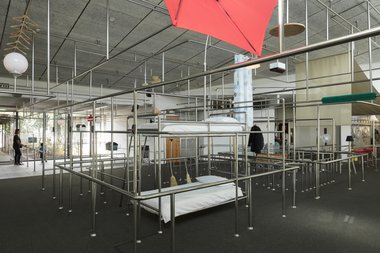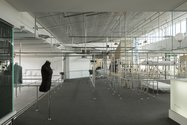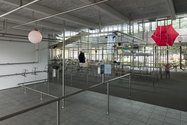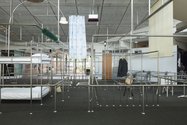John Hurrell – 9 June, 2017
Then there is the other interpretative possibility. You could argue that the barriers reference (by implication) protection from socially damaging and destructive value systems such as racism, sexism, homophobia, ageism, class snobbery etc., that they allude to hidden hostilities that rise to the surface on certain occasions. The steel barriers here are visually unavoidable, but they are so obvious and so dense that there does seem to be a symbolic level that goes beyond the mere protection of the corporeal.
Living in a comparatively under-populated city like Auckland (compared to say the large cities of Europe, or North and South America), it might at first glance seem difficult to get the point of Yona Lee‘s sprawling and amusing installation of stainless steel tubing that meanders through the floors, walls (and at times ceilings) of the corridors, courtyard and many of the rooms of Te Tuhi. Her measured out, bent, cut, fitted and supported railings, with their added unexpected accessories such as working shower nozzles, bunks, bus straps, electric buzzers, mops, music stands, and illuminated light globes, may have strong overtones of Surrealism or even botanical science-fiction, but they also have connotations of crowd control and manipulation of restless (possibly densely packed) human bodies.
Dense linear horizontal obstacles prevent any visitor having effortless spatial access, for the building’s internal volumes are now crisscrossed with an intervening grid. Within this winding, zigzagging labyrinth the attached domestic items range from tables and swings to mailboxes, rubbish tins, tailors’ dummies, umbrellas and brooms. The construction invites playful participation and bodily action - particularly involving arms or hands.
This complex barrier - part jungle gym, part ticket queue organiser, part fetish provider - that so effectively penetrates the heart of the Te Tuhi building, can be extended metaphorically to become a symbolic mechanism for the processes behind creation of the civic self, or the socially ‘productive’, individual human subject. Coerced bodily ‘guidance’(such as that used in airport check-ins or European picture theatres) - or (more subtly) socially advantageous personality construction - is the dominant interpretative mood.
For the latter, it is as if the imposing horizontal steel restraints represent those invisible implementers of social mores that determine and regulate acceptable behaviour. Their ubiquity and density seems to emphasise a symbolism around psychological and community safety - alluding to issues pertaining to what is deemed firstly physically and secondly mentally dangerous.
Most obviously, the safety of the body is a salient theme. Amongst the attached items we have the cleaniness of the living space such as mops, brooms and rubbish tins, the hygiene of the body with showers and taps, and the protection of it from the elements with umbrellas, clothing (tailors’ dummies), and safe public transport (bus straps).
Then there is the other interpretative possibility. You could argue that the barriers reference (by implication) protection from socially damaging and destructive value systems such as racism, sexism, homophobia, ageism, class snobbery etc., that they allude to hidden hostilities that rise to the surface on certain occasions. The steel barriers here are visually unavoidable, but they are so obvious and so dense that there does seem to be a symbolic level that goes beyond the mere protection of the corporeal - a meditation on ‘safety’ in its psychological sense, an espousal of an ideal harmonious world where communities can interact happily (enjoy each other’s distinctive differences) and individuals do their daily tasks free from violence and prejudice.
Going on this reading, it might be claimed that Lee has produced the best kind of activist art, one that is subtle and understated, that has a symbolism that is not heavyhanded, menacing, shrill or declamatory. Its quirky dreamlike poetic qualities draw you in via their incongruous and funny juxtapositions, but with something else going on that is profound, about social relationships, their consequences, and what happens when two strangers meet for the first time.
John Hurrell









 Two Rooms presents a program of residencies and projects
Two Rooms presents a program of residencies and projects Advertising in this column
Advertising in this column



This Discussion has 0 comments.
Comment
Participate
Register to Participate.
Sign in
Sign in to an existing account.